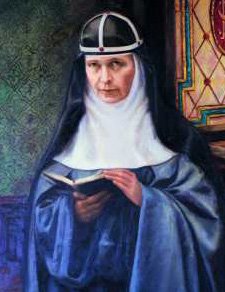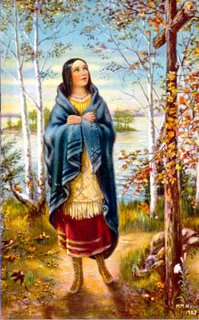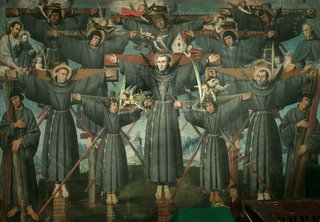
Elizabeth Hesselblad was born in the year 1870, into what would become a very large family of thirteen siblings, even though not all the children survived into adulthood. Still her parents struggled to maintain such a large family and both parents were diligent in the upbringing of their children.
Elizabeth's parents, Auguste and Karin Hesselblad, though caring for their large brood, struggled to make ends meet as they tried running a grocery shop before embarking on opening a bookshop, which barely helped them make ends meet.
Being that Sweden's major religion was Lutheran, so Auguste and Karin raised their children, with a deep Faith in God and a love for the Word of God, as they attended Lutheran services every week almost without fail. It was this faith in God that helped the family persevere through many adversities including the loss of three children at a young age.
Elizabeth would have noted her parent’s strictness and vigilance concerning God and their faith and also the work ethic which both parents tried instill in all their children. But these were also the days before penicillin was discovered so Elizabeth was open to many infections and deadly illnesses, and it was at age 7 that she became very ill with diphtheria and scarlet fever. And though the young Elizabeth recovered from these deadly bouts her health remained fragile all her life as she suffered with stomach ulcers and hemorrhages.
This battle for her health probably also helped to make Elizabeth a little more introspective than her brothers and sisters and also made her realise that life was an adventure and to treasure each moment.
And it was this sense of adventure that led Elizabeth to seek out employment in America in order to help provide for her family but also to gain some monetary security for herself. So it was that in 1888 Elizabeth arrived in New York, to a very different land than that of Sweden. She would have noticed the vibrancy and freshness of this new land and also its diversity as different people migrated to the land of the free.
But Elizabeth was sturdy and stoic by nature, but also with a compassionate heart she sought to work amongst the sick and injured, and so she studied nursing as a way of expressing her love of God and to earn some much needed money.
It was through nursing that Elizabeth's spiritual journey would begin as she came into contact with many Irish and Italian working class people who sought out medical attention. The Faith in God that these patients showed and their great love of the Catholic Church shone through these poor but devout people. This would engage Elizabeth in her own personal struggle to understand just what Catholicism meant and how to encompass it in her own life.
And it was at moments when in need of a break that Elizabeth would wander into Catholic Churches to restore her spirit and energy, it was also here that Elizabeth experienced God in a meaningful way. But it was the Corpus Christi procession when upon seeing the Blessed Sacrament, Elizabeth heard an interior voice speak in the depths of her soul with these words, 'I am the One you seek.'
This confused Elizabeth for though the Lutherans had a great love of God and Scripture she had never heard of experiences such as this, for God had touched this young woman's heart and sought her for Himself. And the more Elizabeth learnt the more she became convinced that God was calling her to enter the Catholic Church. One of the things that truly touched a chord in Elizabeth’s heart was the love many Catholics had for the Blessed Mother, this too would help move Elizabeth to leave her Lutheran roots and convert to the One True Church.
So it was that in 1902, Elizabeth was given a conditional baptism into the Catholic fold and it was also in 1902 that Elizabeth returned to Europe on a pilgrimage to Rome whereupon she received the Sacrament of Confirmation. It was also during this time that Elizabeth felt a calling to enter the Religious life and most especially to embrace the spirit of St. Bridget of Sweden.
But Elizabeth needed to take her first steps in the spiritual life which she did so under the guidance of Mother Hedwig who though she had concerns about the health of this devout woman, still encouraged her to seek God in prayer and the service of others. It was here at the Carmelite community of Saint Bridget that Elizabeth became more convinced to follow in the footsteps of her beloved hero St. Bridget.
And so in 1906 her wish to enter the Religious life was granted and Pope Pius X approved her taking the Habit of the Order of the Most Holy Saviour of Saint Bridget.
The love Elizabeth had for this great Saint was so intense that nothing could prevent her from trying her utmost to revive this great and noble Religious Order. And though she faced many disappointments in her attempts still her heart was replenished when in 1911 she was joined by three English women.
Through many hardships and disappointments Elizabeth never lost sight of her mission and in 1931 she received the Vatican's approval to live and work at the house of Saint Bridget in Rome, where she was made Mother Superior. And through her hard work this Order would reach out to many countries including India.
Elizabeth also during the years of the second world war, helped those who were being persecuted under Nazi tyranny, as she helped clothe and feed the hungry and terrified refugees, this was done at the risk of her own life and her Sisters.
During all this activity though Mother Elizabeth continued to pray for a reconciliation of the many diverse religious denominations, in the hope that others too would return to the Catholic fold and experience the joy in which she had.
She was to maintain this hope of religious reconciliation for the rest of her life.
Elizabeth Hesselblad died in 1957.
Blessed Mary Elizabeth Hesselblad was beatified in the year 2000 by Pope John Paul II.
Some Quotes
"The Lord has called us from different nations, but we must be united with one heart and one soul. In the divine Heart of Jesus we will always meet one another and there we seek our strength to face the difficulties of life. May we be strengthened to practice the beautiful virtues of charity, humility and patience. Then our religious life will be the antechamber to Heaven."
"Our religious houses must be formed after the example of Nazareth: prayer, work, sacrifice. The human heart can aspire to nothing greater."
"Dear Lord, I do not ask to see the path. In darkness, in anguish and in fear, I will hang on tightly to your hand and I will close my eyes, so that you know how much trust I place in you, Spouse of my soul."
Peace of Christ to you ALL
Copyright © 2006 Marie Smith. All rights reserved.




